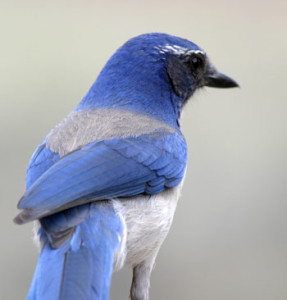Nature Notes by Dr. Frank Lang
There are four different jay species in our area: scrub jays, Steller’s jays, gray jays, and pinion jays in eastern Oregon. None of them are true blue jays. You have to go back east or to Toronto to find them. Jays are bright, clever, fearless. They are, except the gray jay, loud, raucous, and brazen. Both scrub jays and Steller’s jays nest in my neighborhood.

In southwest Oregon and northern California, scrub jays inhabit lower elevations. Robin-sized, the scrub jay has a blue head, wing, rump, and tail, a whitish throat and eyebrows, and grayish back and belly. They lack the crest of blue of the Steller’s jay. They are residents from southwest Washington through the Willamette Valley then east to Wyoming and Colorado and south to southern Mexico. There are also populations in central Texas and southern Florida. The Florida subspecies has a whitish forehead.
Several years ago I was a botanist on an Alaskan cruise ship, the SS Universe. We were sailing north in the Gulf of Alaska just offshore from the Fairview Range. There are no words or photographs to describe the beauty . . . lofty peaks, bathed in pinkish mist rising from a cobalt sea. The only things that compare in my experience are the magnificent oil paintings of Sidney Laurence, dean of Alaskan artists. Early evening the next day I sighted Kayak Island, the only North American landfall of Georg Wilhelm Steller. It was here that Steller found the dark-blue jay that bears his name, a jay that was his clue that he was in North America and not Siberia.
The Steller’s jay is deep blue with a blackish head and jaunty crest. It prefers slightly higher elevations and coniferous woodlands in our area. Steller’s jay is resident from Alaska south through the western United States to Nicaragua. Steller’s jay is the one who lets everyone know when you are sneaking about in the woods, by greeting you with raucous, derisive laughter. One call has fooled me often. Steller’s jays can mimic the call of the red-tailed hawk.
When you stop for lunch at higher elevations in our area, you suddenly discover you are not alone. Gray shadows appear and materialize into the jay some call the whiskey jack, others the camp robber. Gray jays are the quiet members of the group and probably the most fearless, or perhaps the most foolish, trusting humans as they seem to do. They will take advantage of you, helping themselves to nearby or even hand-held edibles. They are gentle companions, with which I don’t mind sharing.
The pinyon jay is blue all over and inhabits the pinyon pine-juniper woodlands of the intermountain west. They are a gregarious lot, found in breeding colonies of up to 150 birds. According to The Birder’s Handbook, they fly in flocks that move in a wheelling mass with rear birds constantly replacing the ones in front. Everyone, it seems, has a turn.
 |
| A Western Scrub-jay, Klamath Falls, Oregon, photo by Rob Mutch |
Jays have a habit of stashing seeds, large numbers of seeds, far more seeds than they can find, to the benefit of those plants whose seeds are lost. The seeds germinate and grow up to the benefit again of both plant and jay.
One summer at my sister’s Sierra cabin I learned how Steller Jays stash goodies and how they might remember where they stashed them. On the flat deck rail my sister laid out a pile of cracked wheat. Steller’s jays showed up to stuff their gular pouches with as much grain as they could and then flew off to stash. While I was waiting to stuff my gular pouch with lunch, a jay flew down and landed on the duff in front of me. Bird then proceeded to stash its cracked wheat. It regurgitated 15 or 20 pieces, pecked a hole in the duff, then placed the wheat in the hole and covered up the stash. Then to my amazement the jay picked up a distinctive looking piece of bark or twig and placed it directly on the stash. Bird repeated this at least ten times. Placement of the unusual piece must be the way they recognize their stash. Clever I’d say.
— Dr. Frank Lang

